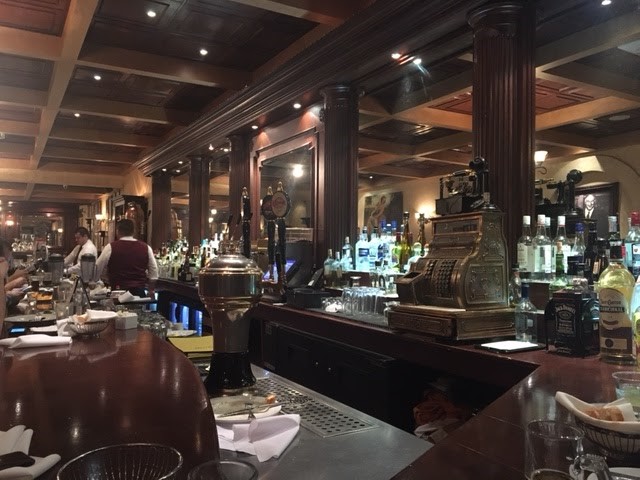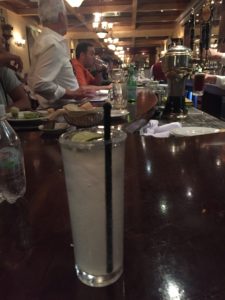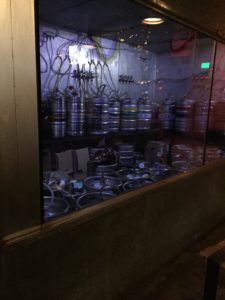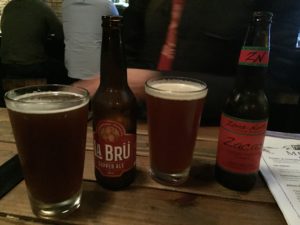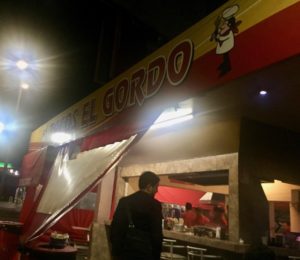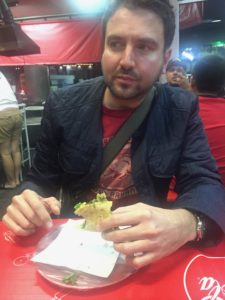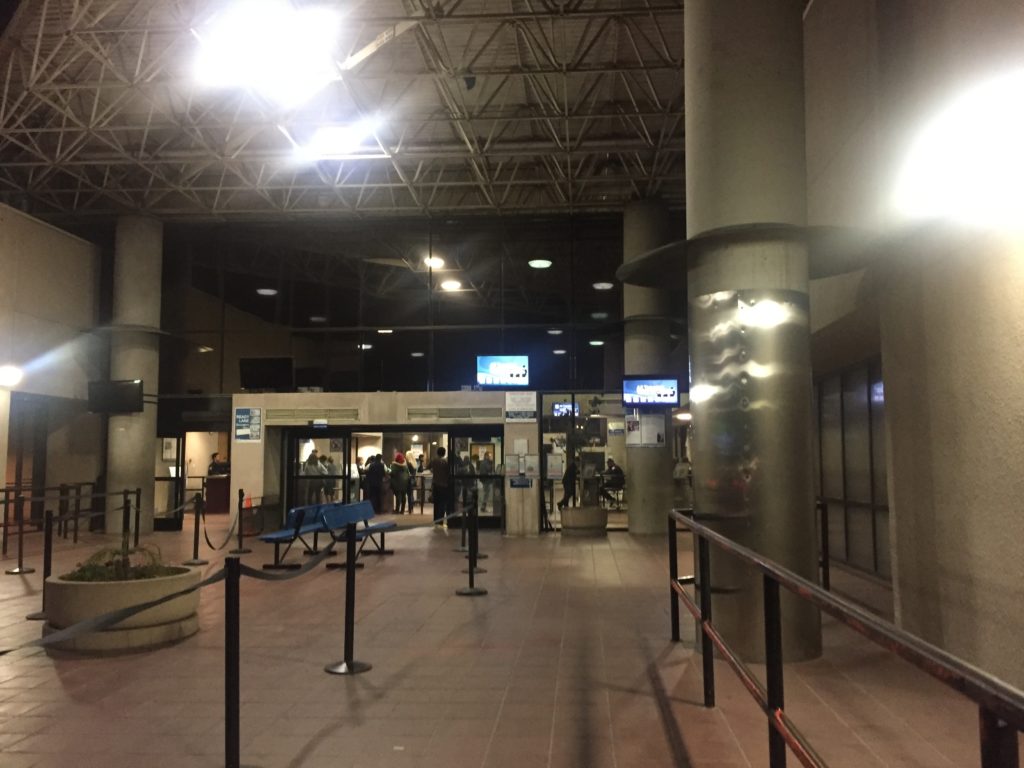[This post is the fourth and final part in a series (Part 0, Part 1, Part 2) that chronicles my experiences on a day trip to Baja California Norte on 2 July 2017.]
Soon after waving farewell in the rear view mirror to Hazy Jesus, Carlos pointed vaguely eastward and said “the wine is over there,” referring to the Valle de Guadalupe. A wine aficionado I am not. I know almost nothing useful about wine and rarely drink it. Carlos made the (accurate) assumption that I wouldn’t care if we skipped the excursion to Mexican Wine Country. I was, however, curious enough to ask Google to find me a $0.10 summary of Mexican wine. “Wine blends are quite popular here, although they don’t always follow European traditions…Mexican wine is still very much a frontier of wine.” The Valle de Guadalupe was featured in the New York Times Travel section last April, so the proverbial cat is out of the bag. 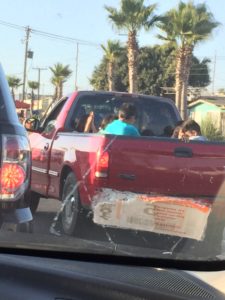
Just north of Rosarito, Carlos spontaneously decided for the sake of variety to veer off to the right to Carretera Federal 1 (a.k.a., Mex 1 Libre), the alternate, toll-free, inland route into Tijuana. We encountered several pickup trucks with entire families riding in the back, which appears to be socially acceptable in Mexico. It is either not illegal or not enforced by traffic cops. Who needs over-engineered car seats– or rear seats at all, for that matter– when you can just throw the kids in the cargo bed and hope for the best? The Border Wall may have stopped helicopter parenting in its tracks.
We drove past many tire stores. There were llanteras literally everywhere. If your vehicle is ever in a need of a replacement tire in Tijuana, I can assure you that they’ve got you covered.
As we descended into Tijuana, we caught sight of a series of large manufacturing facilities, maquiladores, most of which had oversized “Esatamos Occupando” (We’re Hiring) balloons on the roof. Approximately 150,000 people are employed in manufacturing jobs in Tijuana. The medical device workforce has more than doubled in the last six years and now numbers over 40,000. Tijuana attracts many immigrants from the south of Mexico who come to the city in search of employment. Tijuana has also established itself as a center of plasma and LCD television manufacturing. American companies are increasingly taking advantage of the robust pool of skilled workers and labor costs that are up to a factor of five lower than in the US. Tijuana’s location on the map presents compelling logistical advantages over Asian countries that produce goods for the US market. As someone who frequently communicates with colleagues in Malaysia at 2 am, I can appreciate the convenience of being in the same time zone more than most.
 As we approached the city center, we reviewed the plan for the evening– to explore Avenida Revolución, the tourist center of historic Tijuana in Zona Centro, sample some more Mexican craft beer, and eat again. Avenida Revolución was the first paved road in Tijuana. It flourished by harboring dens of iniquity that catered to Americans during Prohibition in the 1920s.
As we approached the city center, we reviewed the plan for the evening– to explore Avenida Revolución, the tourist center of historic Tijuana in Zona Centro, sample some more Mexican craft beer, and eat again. Avenida Revolución was the first paved road in Tijuana. It flourished by harboring dens of iniquity that catered to Americans during Prohibition in the 1920s.
I kept an eye out for a landmark in order to remember the intersection near where we parked. A suitable candidate soon presented itself. Don’t pay more. Just don’t do it.
We encountered several posses of Spanish-speaking Asians, presumably descendants of Chinese laborers who constructed the Mexican railway system at the turn of the 20th century. [A recent surge in immigration to Mexico from non-Latin American countries has garnered media attention.]
Baja California authorities have gone to great lengths to encourage Americans and other English-speaking visitors to feel welcome in Tijuana and thus be more inclined to spend money there and inject it into the local economy. We saw many of these signs advertising help in English for tourists in distress hanging from light posts:
Dialing 911 or 112 (the European equivalent) from any cell phone in Baja California connects to the Mexican emergency services. All English-speaking callers are transferred to bilingual 078 operators. Mexico switched its nationwide emergency number from 066 to 911 in January 2017, an event covered in this hilariously biased Fox News article: “The government apparently seeks to imitate the perceived reliability of the U.S. number.”
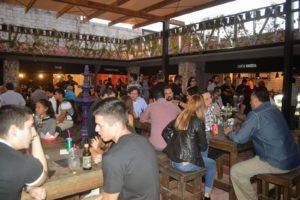 As the sun started to set, we realized that we had gone for altogether too long without beer. We walked past Hotel Caesars, an establishment that claims to have invented the eponymous salad in the 1920s. The bar that Carlos had in mind was closed for a private event, so we continued down the street for a few more blocks, at which point we headed down an alley past a barber shop to Colectivo9 , a small enclave of upmarket street food establishments located here. Since it was nearing closing time (8 pm), our attempt to secure empanadas met with epic failure.
As the sun started to set, we realized that we had gone for altogether too long without beer. We walked past Hotel Caesars, an establishment that claims to have invented the eponymous salad in the 1920s. The bar that Carlos had in mind was closed for a private event, so we continued down the street for a few more blocks, at which point we headed down an alley past a barber shop to Colectivo9 , a small enclave of upmarket street food establishments located here. Since it was nearing closing time (8 pm), our attempt to secure empanadas met with epic failure.
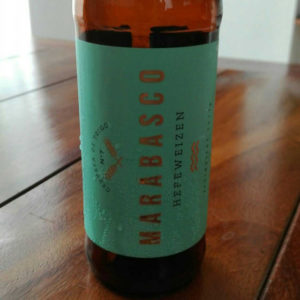 We did succeed in acquiring libations from a small bar nestled in the corner behind a sliding glass door, Barrica 9. I ordered a bottle of Marabasco Hefeweizen from Colima on the Pacific Coast of Mexico brewed from local wheat (photo courtesy of a guy named Omar on Untappd who drank it 2 days ago).
We did succeed in acquiring libations from a small bar nestled in the corner behind a sliding glass door, Barrica 9. I ordered a bottle of Marabasco Hefeweizen from Colima on the Pacific Coast of Mexico brewed from local wheat (photo courtesy of a guy named Omar on Untappd who drank it 2 days ago).
As it happens, Colima also produces about half of all limes grown in Mexico. Fortunately for me, this middle-of-the-road hefeweizen had a low banana quotient, unlike some of its German counterparts. During the fermentation process, Munich wheat beer yeast produces significant amounts of isoamyl acetate, the ester responsible for that hideous banana smell. Carlos selected another Mexican IPA that he said was OK.
The “Beer Marriage” poster on the wall, reproduced on the Barrica 9 Facebook page, caught my eye. It provides sound advice on food/beer pairings: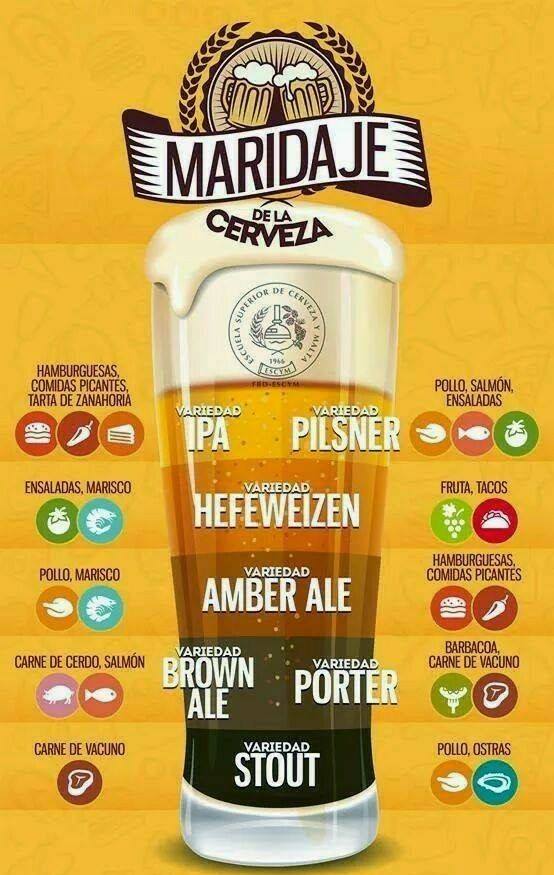
The death metal emanating from the jukebox and a pathetic American guy in his 20s commiserating with the bartender about his troubles with women started to annoy us, so we took our brews out to a table near a waterless fountain. Just as we were about to leave, the bartender popped out to give Carlos his jacket, which he had unconsciously abandoned on a bar stool.
What better way to compensate for being denied hipster empanadas than to stop in for a Caeser salad at the bar of Hotel Caesers? The place has retained its old-school character. The walls were festooned with classic photographs and framed newspaper articles from bygone eras. The bartenders no longer make use of the cash register. Note the point-of-sale terminal partially obscured by the beer taps. We snagged the only two remaining seats at the corner of the bar.
Sticking to my usual “when in Rome” philosophy, I ordered a paloma, a classic Mexican tequila cocktail tragically overshadowed by the margarita. Substitute the triple sec and sweet and sour mix accompanying the tequila for Jarrito’s grapefruit soda and you have yourself a paloma. Add copious amounts of lime juice and lime garnish and serve over ice in a highball glass with a salted rim. All bartenders know that lime is tequila’s best friend.
Carlos attempted once more to order pulpo, but the bartender regretfully informed him that it wasn’t happening for some reason that I didn’t quite catch. I contentedly sipped down my paloma and did what I do best, refrain from talking to anyone. Carlos, however, struck up conversations with our neighbors on either side of us at the bar, which resulted in two “I couldn’t make this shit up if I tried” moments in the space of ten minutes.
The couple to our right had ordered three Tuétano de res rostizado (roasted beef marrow) appetizers, one of the other house specialties (pictured here). Carlos admired the presentation, which prompted the guy to pick one of them up by the fork stuck into it and place it on Carlos’s plate. Carlos looked over towards the wife, who showed no signs of objecting, so he ate it, thanking them profusely. Although never explicitly stated, I suspect that they may have pitied him after overhearing his tales of pulpo woe. As he was finishing it off, the famous salad finally appeared. In the main dining room, they make a big show of assembling it the table, but bar patrons get it unceremoniously plopped in front of them. The recipe is not a closely guarded secret. It exceeded expectations. 
As we chomped away, a white American guy in his sixties and a Mexican woman who looked less than half his age took the seats to our left soon after the previous occupants vacated them. The woman whispered something into his ear and then devoted her full attention to her phone. Her male companion ordered two beers and then exclaimed to Carlos: “Man! I need a drink. I almost got thrown in jail this afternoon.” He then proceeded to regale us with a blow by blow. “I was upstairs in one of the rooms getting some sweet action and smoking some weed. Someone in the hallway must have smelled it and called the cops. I flushed the evidence down the toilet and opened the window and managed to convince them not to arrest me.”
My thought bubble went something like this: “WTF? That is an image that I could have lived without having in my head…TMI…What a lecherous old geezer…I cannot imagine any scenario where that situation would be even remotely appealing for her without a significant financial component…He probably didn’t abide by the Foreign Corrupt Practices Act…Some men are pigs…Oink!” I took one last sip of my paloma in silence and raised my left eyebrow slightly. Carlos managed to change the subject and ended up getting a recommendation from the guy to spend a long weekend at the Bahia de Los Angeles. Human beings are odd creatures.
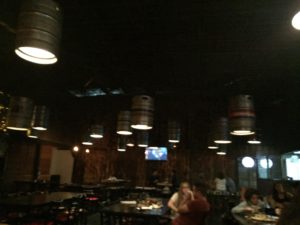 Caeser salad in our bellies, we bid our newfound friends adieu and walked back down the street to Don’t Pay More and the Mazda. Night had fallen, but we both agreed that there was more beer to be had. We headed south to Blvd. Agua Caliente and after driving around in a circle, managed to locate Baja Craft Beers on a side street.
Caeser salad in our bellies, we bid our newfound friends adieu and walked back down the street to Don’t Pay More and the Mazda. Night had fallen, but we both agreed that there was more beer to be had. We headed south to Blvd. Agua Caliente and after driving around in a circle, managed to locate Baja Craft Beers on a side street.
I admired their beer plumbing system and commented to Carlos that we had outfitted the bar at Venture Cafe with a variety of Micromatic keg couplers. In fact, I wrote about keg couplers in great detail on this very blog. The couple next to us interjected that they had been having a debate about the brand of the couplers, which struck me as odd because they all said “Micromatic” on them in large font. But perhaps reading is overrated.
Although predictably not on the menu, two empty Pliny the Elder bottles adorned the wall above the bar.
B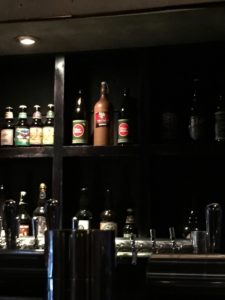 ut I didn’t come to Tijuana to drink beer from Russian River in Santa Rosa, so I again opted for a Mexican brew, La Bru Copper Ale from Morelia, the capital of Michoacán. Morelia is located approximately 300 miles east of Manzanillo, the capital of Colima on the Pacific coast. Manzanillo happens to be the only other place in Mexico that I’ve visited. The most noteworthy aspect of that trip was the drug-dealing surf guide who drove the wrong way on a divided highway and got strip searched by the Mexican army. But that is a story for another time. The beer was decidedly mediocre. It had a weird metallic, bitter aftertaste and was my least favorite beer of the day. It wasn’t nearly as bad as Carlos’s selection, however.
ut I didn’t come to Tijuana to drink beer from Russian River in Santa Rosa, so I again opted for a Mexican brew, La Bru Copper Ale from Morelia, the capital of Michoacán. Morelia is located approximately 300 miles east of Manzanillo, the capital of Colima on the Pacific coast. Manzanillo happens to be the only other place in Mexico that I’ve visited. The most noteworthy aspect of that trip was the drug-dealing surf guide who drove the wrong way on a divided highway and got strip searched by the Mexican army. But that is a story for another time. The beer was decidedly mediocre. It had a weird metallic, bitter aftertaste and was my least favorite beer of the day. It wasn’t nearly as bad as Carlos’s selection, however.
He ordered a Zacas Pale Ale, brewed in Zona Norte of Tijuana, a.k.a. the red light district. Although advertised as an English pale ale, it had a bizarre smoky flavor and was borderline undrinkable. But BCB got an A for effort with the repurposed keg light fixtures. My father, a retired lighting designer, applauded their creativity.
Although the beer we ordered was not the best, it certainly didn’t set us back very much.
As we contemplated heading back to America, I said to Carlos: “It is a categorical imperative that I eat a taco in Mexico.” Immanuel Kant probably spun rapidly in his grave when I said that, but no matter. Carlos consulted Google and we set off towards Tacos El Gordo (“The Fat One”). The synthesized voice in Google Maps had a hilariously bad Spanish accent, but it got us there. Although it was nearly 11 pm at this point, Tacos El Gordo is open until 4 am, even on Sundays.
Carlos ordered us two asada and two pastor tacos. The pastor was probably the best taco I have ever tasted. The asada had an interesting green sauce and, while extremely good, did not quite compare to its pork cousin.
I captured Carlos deep in taco contemplation– an inadvertent Tindr photo for the ages.
Carlos checked the wait times at the two border crossing zones. We opted for the Otay Mesa crossing, about 5 miles east of the main San Ysidro point of entry. I had brought my passport, but neglected to bring the credit card sized Global Entry ID card, so I was not eligible to cross back into the US in the auto express (SENTRI) lane. Additional research suggests that even having the card in my possession might not have been sufficient. As we set off towards the border, Carlos had to brake hard to avoid hitting a man who took it upon himself to run across a poorly lit section of a divided highway. It did not strike me as the wisest decision if self-preservation was a priority for him.
Accessing the Otay Mesa SENTRI lane is not for the faint of heart. It involved a circuitous drive through the eastern outskirts of Tijuana and an abrupt turn back westward to access the border. By the time Carlos dropped me off at the pedestrian crossing zone, it was close to midnight, so there was no line to speak of. The Customs and Border Patrol officer checked my passport and asked “Are you bringing anything back?” I replied: “No.” He waved me along and I re-entered the United States of America on foot. Not my first pedestrian border crossing– I walked between Israel and Jordan and back a few years ago– but surreal nevertheless. I proceeded approximately 100 yards towards a 7-11, at which point Carlos pulled up in the Mazda. The timing could not have been better. A noteworthy ending to a memorable day.
On the drive back to San Diego, we marvelled at the parallel universe aspect of crossing the border. It’s as if a switch gets thrown as soon as you go from one country to the other and separate partitions of your brain get activated.
Postscript: Last Saturday 29 July 2017, I was at AT&T Park, a stone’s throw from my apartment in San Francisco. I decided to buy a hotdog, because that is what one does at baseball stadiums regardless of whether or not baseball is actually being played. In this case, it was not. James Taylor and Bonnie Raitt, staples of my non-New Wave musical lexicon in high school, were performing. It was apparent that my presence was bringing down the average age of the crowd, a phenomenon that rarely occurs these days except at the symphony. In any case, instead of the $20 bill that I was expecting, I pulled out a 500 peso note that I apparently did not spend in Tijuana. It will buy about nine beers the next time I return to Mexico.
Overpriced hotdog and bottle of water in hand (I refuse to drink Coors Lite under any circumstances) I returned to my nosebleed seat with a lovely view of the Bay. Shortly thereafter, James Taylor obliged with a fitting theme song for this series.



